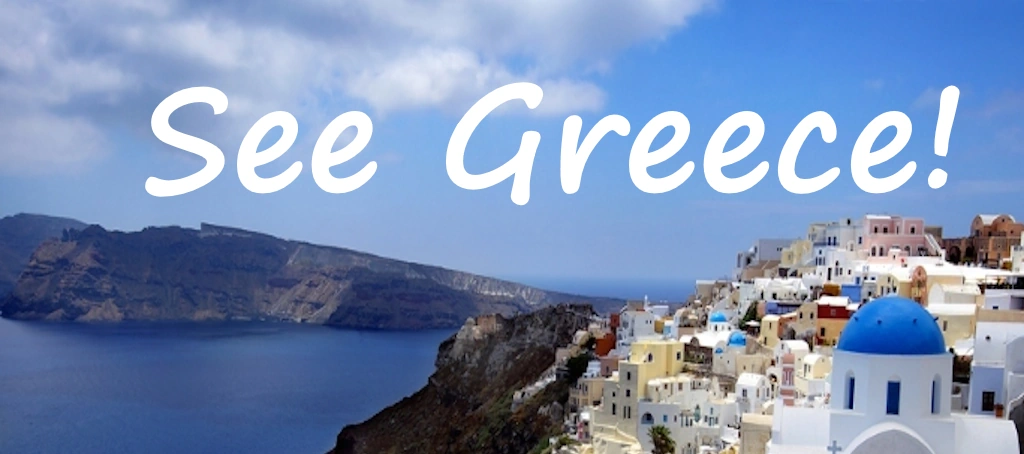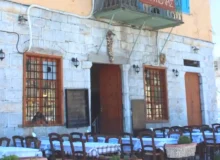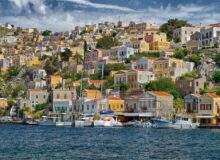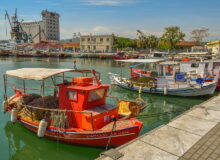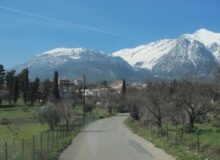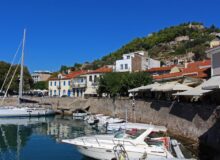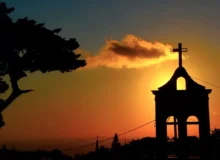Metsovo
The town of Metsovo stands at Greece’s highest mountain pass, between Ioannina and the plains of Thessaly, and has historic mansions and a distinctive cuisine.

To travel from the plains of Thessaly into the region of Epirus involves a drive over the highest road pass in the country, which is 5,599 feet (1,707 m) high and often closed in winter.
Nearby is the lovely mountain town of Metsovo, full of character and atmosphere, reflecting the independent spirit of these tough people who live high in these hills. Some are settled Vlach nomads, although a few hill dwellers still retain the old nomadic lifestyle.
Metsovo is very much on the tourist trail as it’s a ski resort in the winter and popular with hikers in the summer, though it has still lost none of its charm. It has a permanent population of only about 3,000 people, and the drive here, in whichever direction, is one of the best drives in Greece though you can also get here by bus from Ioannina, Kalambaka (near Meteora), or Trikala.

Metsovo History
Metsovo has a rich history dating back to at least 1380 AD, when it was first mentioned as a small settlement of shepherds. Its strategic location on the main passes between northern and southern Greece became crucial to its development.
Under Ottoman rule, from the mid-15th century until 1912, Metsovo often held special privileges, particularly after 1430 and again in 1659. These privileges were granted in exchange for guarding mountain passes and allowed the town a degree of political and economic autonomy, effectively creating an autonomous “federation” with nearby villages. This led to significant prosperity, especially from the 18th century onward. The Vlach (Aromanian) speaking population became known as successful merchants and traders, establishing commerce networks across the Balkans and Europe.

This wealth funded the establishment of schools, churches, and public works, and Metsovo became the birthplace of influential National Benefactors like Georgios Averoff and Michael Tositsas, whose philanthropy greatly supported the Greek state. Despite suffering destruction during an uprising in 1854, the town’s economy boomed in the mid-19th century. Metsovo was finally liberated by the Greek army during the First Balkan War on October 31, 1912.
In the modern era, the legacy of the benefactors, particularly the establishment of the Baron Michael Tositsas Foundation in 1948, has been key to preserving its cultural heritage and developing its economy, focusing on local traditions like woodcarving, cheesemaking, and winemaking.
Metsovo Cuisine

The cuisine of Metsovo is rich, hearty, and deeply connected to its pastoral, Vlach heritage and mountainous setting. It is most famous for two exceptional products: cheese and wine.
The town is the birthplace of the renowned Metsovone, a Protected Designation of Origin (PDO) smoked semi-hard cheese, traditionally made from cow’s milk with a small percentage of sheep’s or goat’s milk. Other local cheeses to try include Metsovela and a local graviera.
Meat features heavily, often roasted over a spit, with local specialties like savory kontosouvli (large pieces of seasoned pork) and unique local sausages, sometimes flavored with wine or Metsovone cheese. Another staple is the wide variety of pies (pites), which are central to Epirot cuisine, often filled with wild greens, cheese, or meat.
Metsovo Wine

Metsovo is also home to the Katogi Averoff Winery, famous for cultivating Greek and international varieties like Cabernet Sauvignon in its high-altitude vineyards, making its local wine a perfect pairing for the robust mountain fare. Dishes often feature local ingredients like wild mushrooms, butter (as olive oil is less common in this climate), and the traditional pasta, trachana. They also have accommodation.
Metsovo Museums
Metsovo Folk Art Museum
The Metsovo Folk Art Museum offers a fascinating glimpse into the culture and wealthy history of the mountain town of Metsovo, Greece. Housed in the rebuilt 17th-century Tositsa Mansion, it was one of the first projects of the Baron Michael Tositsa Foundation, opening in 1955.
The museum is designed as an “open museum,” showcasing rich collections in their natural setting within the manor’s rooms, stables, and parlours, allowing visitors to experience the organization and function of a traditional Metsovo archontiko (mansion).
Key exhibits include:
- Traditional wood-carved furniture, textiles, and gold-embroidered costumes.
- Silverware, decorative items, and everyday household utensils.
- A significant collection of 15th to early 20th-century icons and Byzantine metal items.
- Weapons and swords from the Greek War of Independence in 1821.
The third floor is dedicated to the life and political career of Evangelos Averoff-Tossizza, a major benefactor who oversaw the mansion’s reconstruction and the foundation’s work in revitalising Metsovo. The museum provides a vivid, experiential history lesson about life in this prosperous Epirus region.
Averoff Museum
The Averoff Museum of Neohellenic Art (Averoff Gallery) is one of the most significant museums for modern Greek art in the country.
Overview and History
The museum was founded by Evangelos Averoff-Tossizza (a prominent politician, writer, and descendant of the town’s great benefactors) to fulfill his wish of establishing a high-quality art institution in his hometown. Inaugurated in 1988, the three-story building and its initial collection of 200 works were donated to the Evangelos Averoff-Tossizza Foundation. An expansion in 1994 significantly augmented the exhibition spaces and collection.
Collection and Focus
The permanent exhibition primarily showcases representative works by major Greek painters and sculptors of the 19th and 20th centuries. The collection includes over 700 paintings, sculptures, drawings, and prints and is considered one of the most complete and important collections of this period in Greece.
Visitors can admire masterpieces by renowned artists such as Nikolaos Gyzis, Nikephoros Lytras, Konstantinos Volanakis, and Yannis Moralis. The museum frequently organizes temporary exhibitions and holds a prominent place in the cultural life of the Epirus region.
